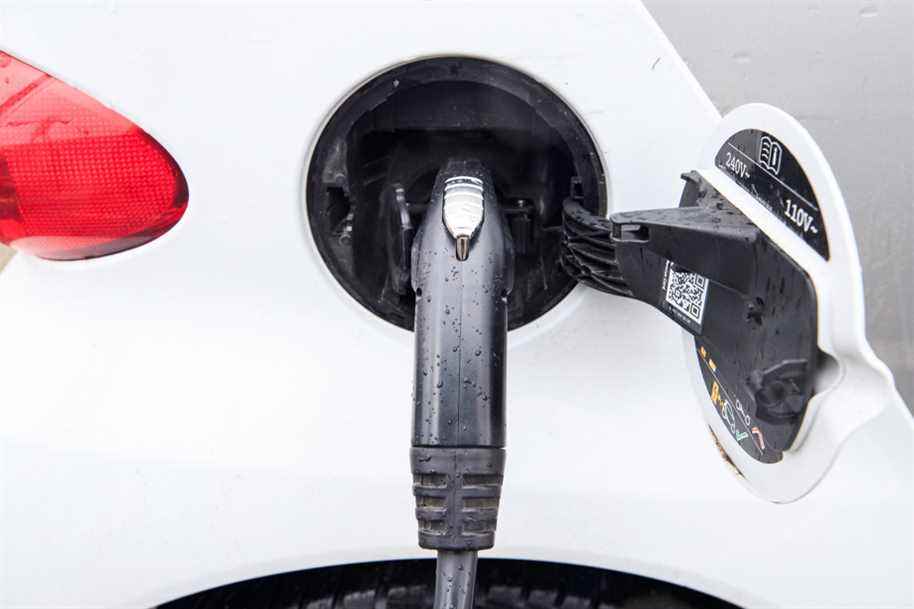(Ottawa) The federal government wants to overhaul the electric vehicle rebate program to more closely match the types of cars Canadians want to buy, says Transport Minister Omar Alghabra.
The Liberals pledged in their campaign platform to spend an additional $ 1.5 billion over the next four years on the zero-emission vehicle incentive program, iVZE. The goal is to get more electric vehicles on the road, as Canada strives to achieve carbon neutrality by 2050.
The current program has been extremely popular, but Minister Alghabra is considering improvements.
Currently, the program limits rebates to new vehicles with a base price of up to $ 45,000 and a maximum price of $ 55,000 for models with higher features.
That will leave out many of the new SUVs and pickups that start flooding the market next year, including the F-150 Lightning electric pickup that Ford says will have a base price of around $ 58,000.
“The vast majority of vehicles purchased today are SUVs and pickup trucks, and although options [véhicule zéro émission] become available for these segments, many of them will be sold outside of the current iZEV program, ”Mr. Alghabra said in a statement from his office.

PHOTO ADRIAN WYLD, ARCHIVES THE CANADIAN PRESS
Minister of Transport, Omar Alghabra
It also omits used vehicles, for which there is an emerging market.
“This is why our government is examining how the program could be revised to better align with current consumer preferences,” said Mr. Alghabra.
In 2020, more than three in four new vehicles registered in Canada were pickup trucks and SUVs, while sedans made up only one in five vehicles.
But due to the models available, over 60% of new zero-emission vehicles registered in 2020 were sedans, and 35% were SUVs and crossovers.
According to Plug’n Drive, an Ontario-based non-profit that promotes the use of electric vehicles, only four zero-emission SUV models are currently available in Canada. None of them are priced low enough to qualify for the discount. There was no van among them.
There are, however, over 40 new electric vehicle models expected over the next two or three years and most of them are pickup trucks and SUVs.
Plug’n Drive President Cara Clairman said the lack of real SUVs and pickup trucks “is a real challenge.”
“This has been a big deal so far, because let’s face it, the first EVs were all pretty small so it was hard to sell to Canadians,” Mr.me Clairman.
The first budget of 300 million allocated to the iZEV program was to last three years, but was exhausted in less than 20 months. Another 287 million was added a year ago, and only 48 million remains.
More than 121,000 vehicles have been purchased with discounts, which range from $ 2,500 for plug-in hybrids to $ 5,000 for battery-only ones. Leased vehicles may be given smaller discounts, depending on the length of the lease.
The 1.5 billion promised during the electoral campaign must last until 2025.
Mme Clairman is among several electric vehicle experts who say rebates aimed at bringing the cost of electric cars more in line with their gasoline equivalents are a vital part of the equation.
The year after Premier Doug Ford canceled Ontario’s rebate program in 2018, new electric vehicle registrations fell 41%. Ontarians registered 38% of all new electric vehicles in 2018. In 2019, it was 17%.
Quebec and British Columbia have both offered discounts for several years and together represent three out of four electric vehicles sold in Canada. They are also the only two provinces with sales mandates that penalize automakers whose sales do not include a minimum proportion of electric vehicles.
Over the past year, Newfoundland and Labrador, Nova Scotia, Prince Edward Island and New Brunswick have all announced discounts on electric vehicles. The Yukon and Northwest Territories added discounts in 2020.
Most of these programs also include assistance with installing electric vehicle chargers in the home.
Rebates don’t come cheap, and some economists argue they’re one of the most expensive ways to cut greenhouse gas emissions. A study led by Christopher Ragan, director of the Max Bell School of Public Policy at McGill University, and published in September 2020 concluded that there are better and cheaper ways to encourage people to use electric vehicles.
According to Alghabra, the first 100,000 cars donated under the iZEV program reduced Canada’s greenhouse gas emissions by about 352,000 tonnes per year, or roughly what 78,000 gasoline-powered cars produce on average in Canada. 12 months. Electric vehicles still produce emissions, including when plug-in hybrids use their gasoline engines and if the electricity used to charge comes from fossil fuels like coal or natural gas.
In his research, Mr. Ragan said that even in Quebec, where almost all electricity comes from hydropower or carbon-neutral wind power, the goal of having a million electric vehicles on the roads here. 2030 would only reduce emissions by 3.6%.
This is a fraction of the goal of reducing total emissions by 37.5%.
In other words, electric vehicles should not be considered the main or even an important means for Quebec to reduce its carbon footprint.
Christopher Ragan, Director of the Max Bell School of Public Policy at McGill University
Electric Vehicle Society president Wilf Steimle said the discounts are a short-term expense to overcome the monetary shock for some drivers until prices become comparable to gasoline vehicles.
“It is important to note not to lose sight of the fact that it is in the short term that the price disparity corrects itself,” he said.
The price difference may vary. Hyundai Canada indicates that the base price of its gasoline Kona model is $ 21,999 and that of an electric model is instead $ 43,699. Ford Canada sells its gasoline Escape model for $ 27,149 and the base plug-in hybrid for $ 35,649.
Analysts at BloombergNEF, which studies the energy transition, said in May that they expected new electric vehicles to be on average cheaper than their gasoline-powered counterparts within five years.
